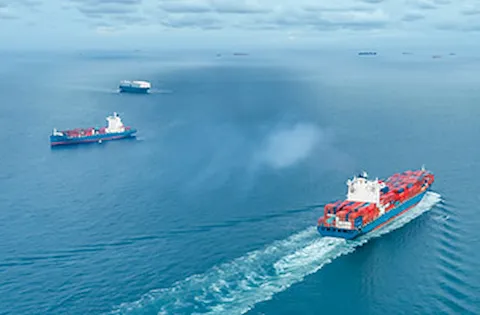New DCS reporting scheme for CII correction factors and out-of-scope activities for MRV
DNV has updated the DCS reporting scheme to apply CII correction factors and voyage adjustments starting from 2023. Also, DNV has improved the functionalities to report activities out-of-MRV-scope; these are activities not serving the purpose of transporting cargo or passengers for commercial purposes. This statutory news explains how these new measures work.
Relevant for shipowners and managers.
CII correction factors and voyage adjustments
The Carbon Intensity Indicator (CII) measures how efficiently a ship transports goods or passengers and is given in grams of CO2 emitted per cargo-carrying capacity and nautical mile. The ship is then given an annual rating ranging from A to E, where A is the best, whereby the rating thresholds will become increasingly stringent towards 2030.
From 2024, cargo, cruise and RoPax ships must calculate their CII value, based on reported fuel oil consumption data from the previous year. The basis for the CII calculations is reported DCS emissions data. The IMO recently decided that certain vessels under certain conditions could get a “correction” to their CII evaluation, either by removing certain periods of their operation or by reducing the CII value based on given criteria.
To use such CII correction factors would require vessels to report additional information throughout the reporting year. Therefore, DNV has described how the specifications from the IMO impact DNV’s data reporting requirements and how the new corrected CII value is calculated. For more detailed information on how to apply CII correction factors and voyage adjustments to vessel’s reporting, see Appendix in the pdf version below.
The “corrected CII” will be calculated separately from the CII without the correction factors and both will be made available.
Out-of-scope activities for MRV
The MRV regulations require reporting of emissions, distances and times from transport related voyages falling within the MRV scope. Movements, however, which do not serve the purpose of transporting cargo or passengers for commercial purposes, fall outside of the MRV scope and may be excluded from the Emissions Report.
To facilitate the reporting of out-of-scope activities, DNV had introduced the so-called “offhire reporting” some time back. This functionality has now been expanded and operators may report out-of-scope activities in the event-reporting using two options, namely:
- The old option: marking entire voyage or port legs as out-of-scope or
- The new option: facilitating to mark certain periods within legs as out-of-scope. We recommend our customers to switch to the new reporting option for increased accuracy and ease of use.
The following principles apply:
- Generally, to mark an event or a voyage/port-leg as non-MRV-relevant, offhire-events must be used. It is the company’s responsibility to report this correctly and the reporting will be verified.
- New reporting (recommended): For the reporting period 2022 onwards, each single event should be marked as offhire by adding a reason in the OffhireReason column. The reason must be repeated on each single event when the vessel is Offhire. Offhire is out-of-scope for MRV only when the Offhire reason is containing “DryDocking”, “Emergency” or “LaidUp”. This also means that the events “BeginOfOffhire” and “EndOfOffhire” are no longer required.
- Old reporting: Using the event names “BeginOfOffhire” and “EndOfOffhire” will still work. Note that to begin an offhire period, it is no longer sufficient to add a reason only, you must use the “BeginOfOffhire” event, or you must repeat the reason on every event throughout the offhire period.
- Note that for an Offhire period to be taken out-of-scope for MRV, it must last minimum 24 hours.
- While the above mentioned reporting principles can be applied from 1 Jan 2022, DNV’s system will be updated early September and will from then on also consider the added offhire event logic for the emissions reports, in time for the ER-verification cycle in 2023.
Recommendations
We recommend that operators familiarize themselves with the new option to report activities out of the MRV scope, and to apply correction factors for the 2022 data onwards as applicable.
Appendix
Please see pages 3-4 for in the pdf version available below for DNV Reporting Scheme for CII Correction Factors and Voyage Adjustments (effective January 2023)
References
- DNV's MRV & DCS website
- EMSA's FAQs addressing out-of-scope activities
- DNV's Carbon Intensity Indicator website
Contact
- For customers:
DATE - Direct Access to Technical Experts via My Services on Veracity. - Otherwise:
Use our office locator to find the nearest DNV office.
